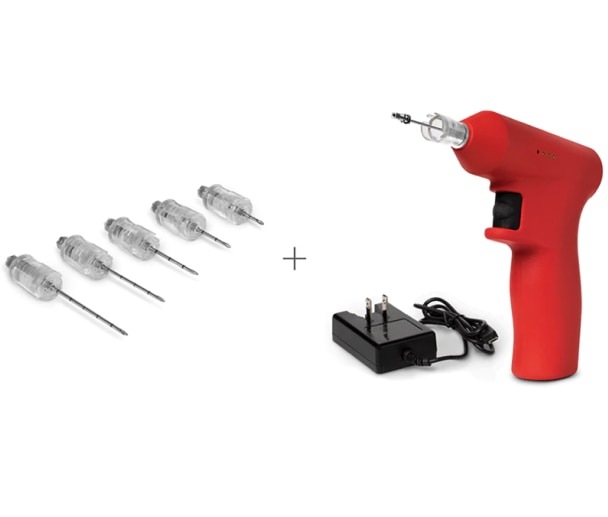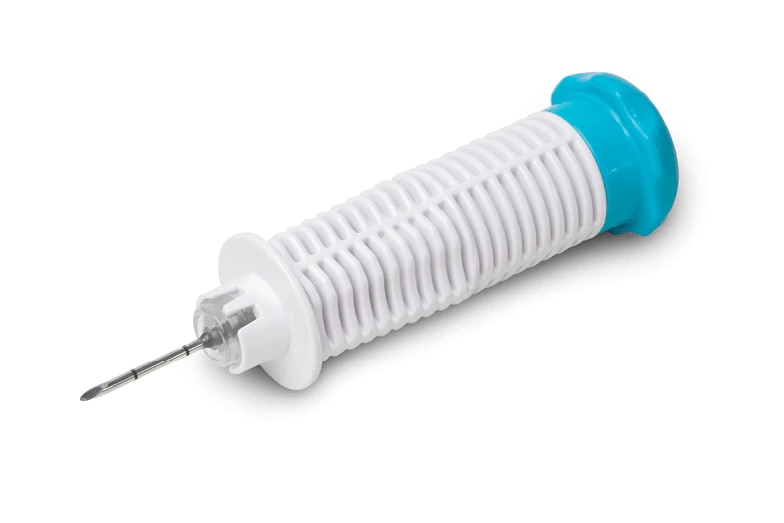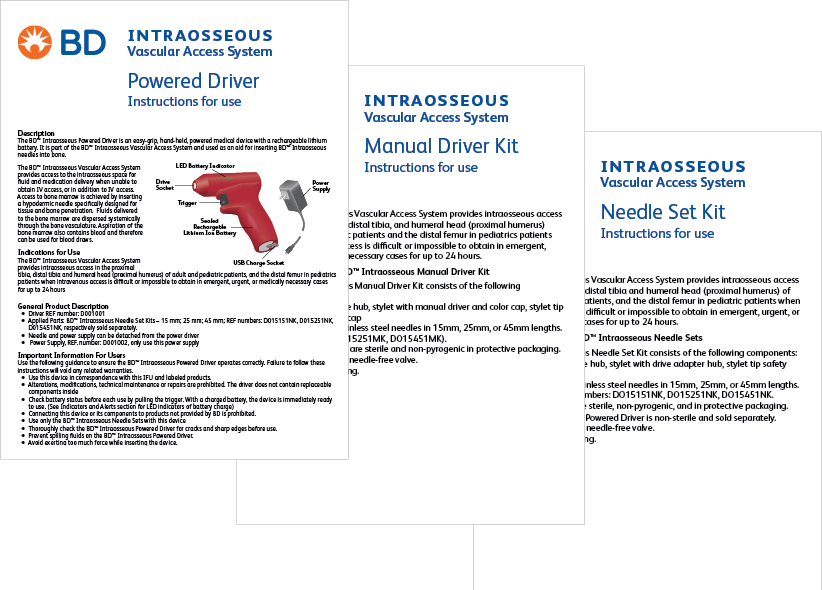BD™ Intraosseous Vascular Access System
Safety. Reliability. Performance. Explore the evolution of IO.


- Overview
- Applications
- Products & Accessories
- EIFU & Resources
Alerte : BD annonce le rappel volontaire de produits intra-osseux
Every day, you make decisions that save lives. Even in the chaotic moments where every second matters, you know what the patient needs, and the best treatment plan for them.
When IO access is the best option for vascular access, clinicians and emergency care providers can trust the BD™ Intraosseous Vascular Access System to deliver fluids and/or medications safely during resuscitations and life-saving procedures.
With innovations designed to deliver safety, reliability and performance, the BD™ Intraosseous Vascular Access System offers enhanced control and a safety feature designed to protect against needlestick injuries.
4 reasons why...
The BD™ Intraosseous Vascular Access System is unique
The only IO powered driver with a rechargeable battery that lasts up to 12× longer than the non-rechargeable Teleflex EZ-IO1
Demo the BD™ Intraosseous Vascular Access System now
Click on each hot spot below to take a closer look at how we are evolving IO access

- 1
- 2
- 3
- 4
- 5
- 6
- 7
Patented, integrated passive stylet tip designed to protect healthcare providers from inadvertent needlesticks in emergent situations—the only IO needles with this feature
Color-coded needle packaging to quickly communicate needle length
Comprehensive selection of five stainless steel needles (15mm, 25mm, 35mm, 45mm, 55mm) so you can feel confident you can select the length you need to safely achieve IO access in patients of all sizes
Multi-light battery indicator provides instant identification of battery charge status, so you can be confident that the powered driver is ready to perform
Instant action with a powered driver that stops immediately upon releasing the trigger
Ergonomic design with longer handle than Teleflex EZ-IO, accommodating larger hands more comfortably
Rechargeable battery that lasts up to 12× longer than the non-rechargeable Teleflex EZ-IO
Safety, reliability, performance—we have evolved them all for IO access, so that you can choose the right tool at the right time in every emergent scenario. And whether you prefer to achieve IO access manually or with a powered driver, every component of the BD™ Intraosseous Vascular Access System is designed to help your practice and meet the moment in the ED or EMS environment.
Click on each hot spot below to take a closer look at how we are evolving IO access

- 1
- 2
- 3
- 4
Comprehensive needle lengths
The BD Intraosseous Manual Driver is offered in five needle lengths so you can feel confident you will have the length you need to safely achieve IO access in patients of all sizes
Passive needle tip safety
The only IO manual driver with an integrated passive needle tip safety designed to decrease needlestick injuries
Gripped ergonomic handle designed to increase controlled insertion into the vascular space
Color-coded handle quickly communicates needle length
If you prefer to achieve IO access manually, we also offer the BD™ Intraosseous Manual Driver, which uses pressure from the user to push a needle into the IO space. A single-use disposable hypodermic needle is connected to a needle hub, and a stylet is connected to the manual driver.
Click on each hot spot below to take a closer look at how we are evolving IO access
BD™ Intraosseous Securement Device
BD™ Intraosseous Securement Device features a unique contoured shape designed to provide stabilization on the contours of any relevant anatomy.
BD MaxZero™ Extension Set with BD MaxZero™ Needle-free Connector
Provides access for continuous infusions and can be disinfected with a 3 second disinfection protocol.

- 1
- 2
- 3
- 4
Packaged with the needle set or manual driver kit, eliminating the hassle of having to reach for a separate stabilization device
Can be placed either before or after the extension set minimizing procedure steps
Includes BD MaxZero™ Needle-free Connector
BD Max™ T-Connector provides additional access point for use in emergent situations enabling continuous infusions of critical medications
Safety. Reliability. Performance.
Safety
Helping you to ensure the safety of patients and healthcare providers is our top priority
Reducing needlestick injuries
Needlestick injuries are an ongoing safety hazard to healthcare providers, causing fear, anxiety and emotional distress in workers2,3 and costing the hospital up to $3,766 on average per exposure.2
BD™ Intraosseous Needles are the only IO needles that feature an integrated passive needle tip safety designed to protect against needlestick injuries. So, the BD™ Intraosseous Vascular Access System can protect healthcare workers from inadvertent needlesticks, that are especially common in emergent settings:
- Aligned with INS Infusion Therapy Standards of Practice that recommend “the use of passive safety-engineered devices for needlestick injury prevention”4
- Complies with ISO standards and guidance by FDA for sharps injury prevention5,6
- Integrated passive needle tip safety is available on all five needle sizes.
Safe IO access insertions
Unsuccessful insertions increase delays in treatment, reduce patient satisfaction and significantly increase risk of complications.7 Over 33% of adults and up to 50% of children who present to a hospital and require a PIVC are reported to have difficult venous access (DVA), making first-attempt success harder to achieve.8
The BD™ Intraosseous Powered Driver is designed with innovations to safely accommodate insertions for all patients:
- Enabling IO access in both adult and pediatric patients when IV access is difficult or impossible to obtain in emergent, urgent, or medically necessary cases for up to 24 hours
- Rechargeable battery that lasts up to 12× longer than the non-rechargeable Teleflex EZ-IO1 for confidence and reliability
- Securement device helps prevent dislodgement of the IO cannula
Our clinical experts, backed with tools like the IO Competency Checklist and the Clinical Presentation can help your facility safely upgrade to the BD™ Intraosseous Vascular Access System.
Let's get started
Reliability
Giving you the confidence of being ready to perform an IO access procedure any time
Reliable access every time
IO access is a reliable bridging method to gain vascular access for in-hospital adult emergency patients under trauma or medical resuscitation with impossible peripheral IV access.9
The BD™ Intraosseous Vascular Access System is a high-quality and reliable device with innovations you can count on every time:
- Long-lasting rechargeable battery in the BD™ Intraosseous Powered Driver with 12x more total battery life than the non-rechargeable Teleflex EZ-IO1
- Powered driver stops immediately upon releasing the trigger
Ready to work when you need it
Time and performance are critical in the ED and EMS settings, often requiring life-saving decisions to be made in seconds.
The BD™ Intraosseous Vascular Access System is designed with multiple visual indicators, so you can be confident that the device is powered and ready for an IO access procedure:
- Easy recharging with Micro-USB charge socket enables you to know the BD™ Intraosseous Powered Driver is ready to use exactly when needed
- Multi-light battery indicator on the BD™ Intraosseous Powered Driver provides instant identification of battery charge status
Let's get started
Performance
Enabling you to be more comfortable and efficient for every IO access procedure
Increased control, in your hands
Ergonomics and ease of use are not just nice-to-have features—they are factors that can impact control and efficiency in clinical procedures.
The BD™ Intraosseous Vascular Access System is an easy-to-use device with innovations designed to improve user experience:
- The BD™ Intraosseous Powered Driver is ergonomically designed for user comfort
- Can accommodate larger hands more comfortably
- Gripped ergonomic handle of the BD™ Intraosseous Manual Driver is designed to increase controlled insertion into the vascular space
- Snap-on feature of the securement device allows it to be placed independently of the extension set, eliminating the need to disconnect and reconnect the extension set
Our experts can offer product in-service training and learning sessions to help your clinicians improve their technique and proficiency in IO access.
Let's get started
More speed in IO procedures
While the skill and experience of the clinician play a large role in successful placements, product design can reduce procedural steps and improve clinical efficiency.
The BD™ Intraosseous Vascular Access System is designed with features to help users minimize IO procedure steps without compromising on stability and safety:
- Powered driver with rechargeable battery for faster IO placement than impact-driven methods.
- BD™ Intraosseous Manual Driver is designed to allow continual insertion avoiding the need to reposition the hand during the procedure.
- Securement device allows stabilization of the IO device at multiple angles and minimizes procedure steps compared to Teleflex EZ-IO.
- Snap-on feature of the securement device allows the IO device to be placed independently of the extension set, eliminating the need to disconnect and reconnect the extension set.
- BD MaxZero™ Extension Set with BD MaxZero™ Needle-free Connector provides access for infusions and can be disinfected in just 3 seconds, enabling ongoing infusion of medication to patients and optimized performance for clinicians.
- Color-coded needle packaging to quickly communicate needle length.
Let's get started
This is a modal window.
Beginning of dialog window. Escape will cancel and close the window.
End of dialog window.
This is a modal window. This modal can be closed by pressing the Escape key or activating the close button.
BD™ Intraosseous Powered Driver overview animation
This is a modal window.
Playback Denied: Unavailable
Beginning of dialog window. Escape will cancel and close the window.
End of dialog window.
This is a modal window. This modal can be closed by pressing the Escape key or activating the close button.
BD™ Intraosseous Manual Driver overview animation
Lead the change to become proficient in the next generation of IO access
IO access is recommended by multiple professional industry associations—such as the American College of Emergency Physicians (ACEP),10 the Emergency Nurses Association (ENA),11 the American Heart Association (AHA),12 the Infusion Nurses Society (INS)13 and the National Association of EMS Physicians (NAEMSP)14,15—for situations where care is compromised without rapid vascular access and IV access is not available.
ACEP Policy Statement
There are situations in the emergency department when intravenous access procedures fail or are insufficient to meet the clinical needs of the patient. Alternative access methods must be available under such circumstances and their usage should be a part of the emergency medicine practice privileges. These alternate access modalities include, but are not limited to, intraosseous lines.10
INS Infusion Therapy Standards of Practice 2021
IO access has a reported high rate of first-time insertion success with low complications. Insertion of an IO device may avoid delays to delivery of necessary medication and fluid. [...] Anticipate use of the IO route in the event of adult or pediatric cardiac arrest if IV access is not available or cannot be obtained quickly. Pediatric advanced life support guidelines recommend the use of the IO route as the initial vascular access route in case of cardiac arrest.13
NAEMSP Position Statement for Out-of-Hospital Settings
IO access may be appropriate for primary vascular access in select cases.14 In out-of-hospital environments, IO access may provide significant time savings that could benefit patients in emergent situations by decreasing the time required to achieve access and the time required to administer the necessary fluids and medications.15
Let's get started
See how you and your team can use the BD™ Intraosseous Vascular Access System for IO access in your ED or EMS System
This is a modal window.
Beginning of dialog window. Escape will cancel and close the window.
End of dialog window.
This is a modal window. This modal can be closed by pressing the Escape key or activating the close button.
BD™ Intraosseous Powered Driver overview animation
This is a modal window.
Playback Denied: Unavailable
Beginning of dialog window. Escape will cancel and close the window.
End of dialog window.
This is a modal window. This modal can be closed by pressing the Escape key or activating the close button.
BD™ Intraosseous Manual Driver overview animation
We offer clinical support 24/7/365
Our Medical Information (MI) team of scientists and nurses is available via phone at 1-800-555-7422 and email to answer any technical or clinical questions you might have about BD products, and the procedures in which they are used.
Le corpus de publications de BD sur le secteur et nos offres vous donnent des informations que vous pouvez utiliser pour continuer à viser l’excellence.
BD met à votre disposition des ressources de formation pour vous aider à améliorer vos pratiques cliniques, dans le cadre de notre objectif « faire progresser le monde de la santé ».
BD soutient le secteur des soins de santé en proposant des produits et des services de pointe pour améliorer les soins tout en diminuant les coûts. Nous organisons des événements et participons à des rencontres qui excellent à faire progresser le monde de la santé, conformément à notre devise « faire avancer le monde de la santé™ ».
BD promeut l’excellence clinique en fournissant diverses ressources sur les bonnes pratiques, les innovations cliniques et les tendances du secteur de la santé.
Please consult product labels and inserts for any indications, contraindications, hazards, warnings, precautions and directions for use.
- Internal file at BD (M661-048.0 dated 10/15/2019)
- Lee J, Botteman M, Nicklasson L. A Systematic Review of the Economic and Humanistic Burden of Needlestick Injury in the United States. Am J Infect Control. 2004;32(3):E43. doi: 10.1016/j.ajic.2004.04.064.
- Green B, Griffiths EC. Psychiatric consequences of needlestick injury. Occupational Medicine. 2013;63:183–188. doi: 10.1093/occmed/kqt006.
- Gorski L, Hadaway L, Hagle ME, McGoldrick M, Orr M, Doellman D. Infusion Therapy Standards of Practice. J Infus Nurs. 2016;39(1):S1–S159.
- IO Needle Patent.
- ISO Standard 23908.
- Kusminsky RE. Complications of central venous catheterization. J Am Coll Surg. 2007;204(4):681–696. doi: 10.1016/j.jamcollsurg.2007.01.039.
- Sou V, McManus C, Mifflin N, Frost SA, Ale J, Alexandrou E. A clinical pathway for the management of difficult venous access. BMC Nurs. 2017;16:1–7. doi: 10.1186/ s12912-017-0261-z 2018.
- Leidel BA, Kirchhoff C, Bogner V, et al. Is the intraosseous access route fast and efficacious compared to conventional central venous catheterization in adult patients under resuscitation in the emergency department? A prospective observational pilot study. Patient Saf Surg. 2009;3(1):24. doi: 10.1186/1754-9493-3-24.
- Alternative Methods to Vascular Access in the Emergency Department. American College of Emergency Physicians (ACEP) website. https://www.acep.org/patient-care/policy-statements/alternative-methods-to-vascular-access-in-the-emergency-department/. Published June 2011. Revised January 2017. Accessed March 31, 2021.
- Position Statement - The Role of the Registered Nurse in the Use of Intraosseous Vascular Access Devices. Emergency Nurses Association (ENA) website. http://www.ena.org/docs/default-source/resource-library/practice-resources/position-statements/joint-statements/roleofrnininsertionof-ioaccessdevicepositionpaper.pdf?sfvrsn=e5f8b8f9_16. Published December 2019. Accessed May 27, 2021.
- Kleinman ME, Chameides L, Schexnayder SM, et al. Part 14: Pediatric Advanced Life Support. 2010 American Heart Association Guidelines for Cardiopulmonary Resuscitation and Emergency Cardiovascular Care. 2010;122(3):S876–S908.
- Gorski LA, Hadaway L, Hagle ME, et al. INS Infusion Therapy Standards of Practice. 8th Edition. Revised 2021. J Infus Nurs. 2021;44(1):S1–S224. doi: 10.1097/NAN.0000000000000396.
- Fowler R, Gallagher JV, Isaacs SM, Ossman E, Pepe P, Wayne M. The role of intraosseous vascular access in the out-of-hospital environment (Resource document to NAEMSP Position Statement). Prehosp Emerg Care. 2007;11(1):63–66. doi: 10.1080/10903120601021036
- O'Connor RE. Intraosseous Vascular Access in the Out-of-Hospital Setting Position Statement of the National Association of EMS Physicians. Prehosp Emerg Care. 2007;11(1):62. doi: 110.1080/10903120601020939
BD-39706 (8/21)

